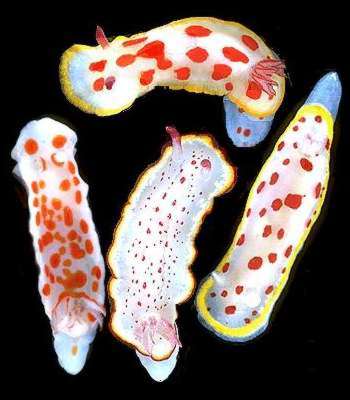
Mimicry - red-spotted chromodorids
PHOTO
Top: Chromodoris splendida. Lower left: Chromodoris tasmaniensis. Lower centre: Chromodoris daphne. Lower right: Chromodoris hunterae.
PHOTOS: Bill Rudman.
RELATED TOPIC
There are many examples of animals which have evolved to look almost identical to another animal. Have a look at the mimicry page for further information.
In south eastern Australia many of the species of chromodorid found there are found nowhere else, and there is a group of species which all have a red-spotted colour pattern. We think this mimicry has evolved so that potential predators, such as fish, learn more quickly that red spots are a sign that the animal has large glands of distasteful chemicals in their mantle. Chromodorids all have mantle glands which contain chemicals that are distasteful to fish. The chemicals are from the sponges they feed on. When poisonous animals have warning colours like this we call it aposematic colouration.
References:
• Rudman, W.B. (1991) Purpose in Pattern: the evolution of colour in chromodorid nudibranchs.Journal of Molluscan Studies, 57, (T.E. Thompson Memorial Issue): 5-21.
Rudman, W.B., 2004 (July 23) Mimicry - red-spotted chromodorids. [In] Sea Slug Forum. Australian Museum, Sydney. Available from http://www.seaslugforum.net/factsheet/redspot
Related messages
-
Two more SE Australian endemics
From: Bill Rudman, June 3, 1999 -
Endemic SE Australian chromodorids
From: Austin, June 1, 1999 -
Ten SE Australian endemic chromodorids
From: Bill Rudman, June 1, 1999
